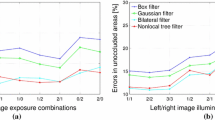Abstract
To cope with the problem of the vast majority local stereo matching approaches that rely highly on the statistical characteristics of the image intensity, a novel non-parametric transform stereo matching method based on mutual relationship is proposed. The traditional non-parametric transform is investigated, and its limitations are analyzed. In order to take the pixels’ special location information into consideration during finding stereo correspondences, the original gray values of the neighborhood pixels whose relative position is one unit greater than that of the center pixel are replaced by the gray values interpolation of the four pixels surrounding it. Then the new non-parametric transform stereo matching is performed. The proposed approach is tested with both the standard image datasets and the images captured from realistic scenery. Experimental results are compared to those of intensity-based algorithms; the percentage of bad matching pixels is almost equivalent to the other examined algorithms, and the proposed algorithm exhibits robust behavior in realistic conditions.










Similar content being viewed by others
Explore related subjects
Discover the latest articles, news and stories from top researchers in related subjects.References
Zhang J, Liu P, Zhang F, Song Q (2018) Cloudnet: ground-based cloud classification with deep convolutional neural network. Geophys Res Lett 45(16):8665–8672
Xu C, Xu L, Gao Z, Zhao S, Zhang H, Zhang Y, Du X, Zhao S, Ghista D, Liu H (2018) Direct delineation of myocardial infarction without contrast agents using a joint motion feature learning architecture. Med Image Anal 50:82–94
Gao Z, Xiong H, Liu X, Zhang H, Ghista D, Wu W, Li S (2017) Robust estimation of carotid artery wall motion using the elasticity-based state-space approach. Med Image Anal 37:1–21
Gao Z, Li Y, Sun Y, Yang J, Xiong H, Zhang H, Liu X, Wu W, Liang D, Li S (2017) Motion tracking of the carotid artery wall from ultrasound image sequences: a nonlinear state-space approach. IEEE Trans Med Imaging 37(1):273–283
Pollefeys M, Nister D, Frahm J, Akbarzedeh A, Mordohai P, Clipp B, Engels C, Gallup D, Kim S, Merrel P, Salmi C, Sinha S, Talton B, Wang L, Yang Q, Stewenius H, Yang R, Welch G, Towles H (2008) Detailed real-time urban 3D reconstruction from video. Int J Comput Vis 78(2–3):143–167
Hu X, Mordohai P (2012) A quantitative evaluation of confidence measures for stereo vision. IEEE Trans Pattern Anal Mach Intell 34(11):2121–2133
Scharstein D, Szeliski R (2002) A taxonomy and evaluation of dense two-frame stereo correspondence algorithms. Int J Comput Vis 47(1/2/3):7–42
Zitnick C, Kang S (2007) Stereo for image-based rendering using image over-segmentation. Int J Comput 75(1):49–65
Claus A, Sormann A, Kamer K (2006) Segment-based stereo matching using belief propagation and a self-adapting dissimilarity measure. In: IEEE international conference on pattern recognition. IEEE, pp 15–18
Yang Q, Wang L, Ahuja N (2010) A constant-space belief propagation algorithm for stereo matching. In: IEEE International Conference on Computer Vision and Pattern Recognition, IEEE, pp 1458-1465
Birchfield S, Tomasi C (1998) A pixel dissimilarity measure that is insensitive to image sampling. IEEE Trans Pattern Anal Mach Intell 20(4):401–406
Hirschmuller H (2008) Stereo processing by semiglobal matching and mutual relationship. IEEE Trans Pattern Anal Mach Intell 30(2):328–341
Clancar G, Kristan M, Karba R (2004) Wide-angle camera distortions and nonuniform illumination in mobile robot tracking. Robot Auton Syst 46(2):125–133
Zabih R, Woodfill J (1994) Non-parametric local transforms for computing visual correspondence. In: European conference on computer vision. Springer, pp 151–158
Sloan KR, Tanimoto SL (1979) Progressive refinement of raster images. IEEE Trans Comput C-28(11):871–874
Hartley RI (1999) Theory and practice of projective rectification. Int J Comput Vis 35(2):115–127
Barron JL, Fleet DJ, Beauchemin SS (1994) Performance of optical flow techniques. Int J Comput Vis 12(1):43–77
Szeliski R (1999) Prediction error as a quality metric for motion and stereo. In: IEEE international conference on computer vision. IEEE, pp 781–788
Wang Z, Zheng Z (2008) A region based stereo matching algorithm using cooperative optimization. In: IEEE conference on computer vision and pattern recognition. IEEE, pp 1–8
Nalpantidis L, Gasteratos A (2010) Stereo vision for robotic applications in the presence of non-ideal lighting conditions. Image Vis Comput 28(6):940–951
Olague G, Fernandez F, Pérez C, Lutton E (2006) The infection algorithm: an artificial epidemic approach for dense stereo correspondence. Artif Life 12(4):593–615
Acknowledgements
This work is funded in part by National Natural Science Foundation of China (Grant No. 61602419), and also supported by Natural Science Foundation of Zhejiang Province of China (Grant Nos. LY16F10008, LQ16F020003).
Author information
Authors and Affiliations
Corresponding author
Ethics declarations
Conflict of interest
We declare that all authors have no conflicts of interest in the authorship or publication of this contribution.
Rights and permissions
About this article
Cite this article
Lai, X., Xu, X., Lv, L. et al. A novel non-parametric transform stereo matching method based on mutual relationship. Computing 101, 621–635 (2019). https://doi.org/10.1007/s00607-018-00691-3
Received:
Accepted:
Published:
Issue Date:
DOI: https://doi.org/10.1007/s00607-018-00691-3



